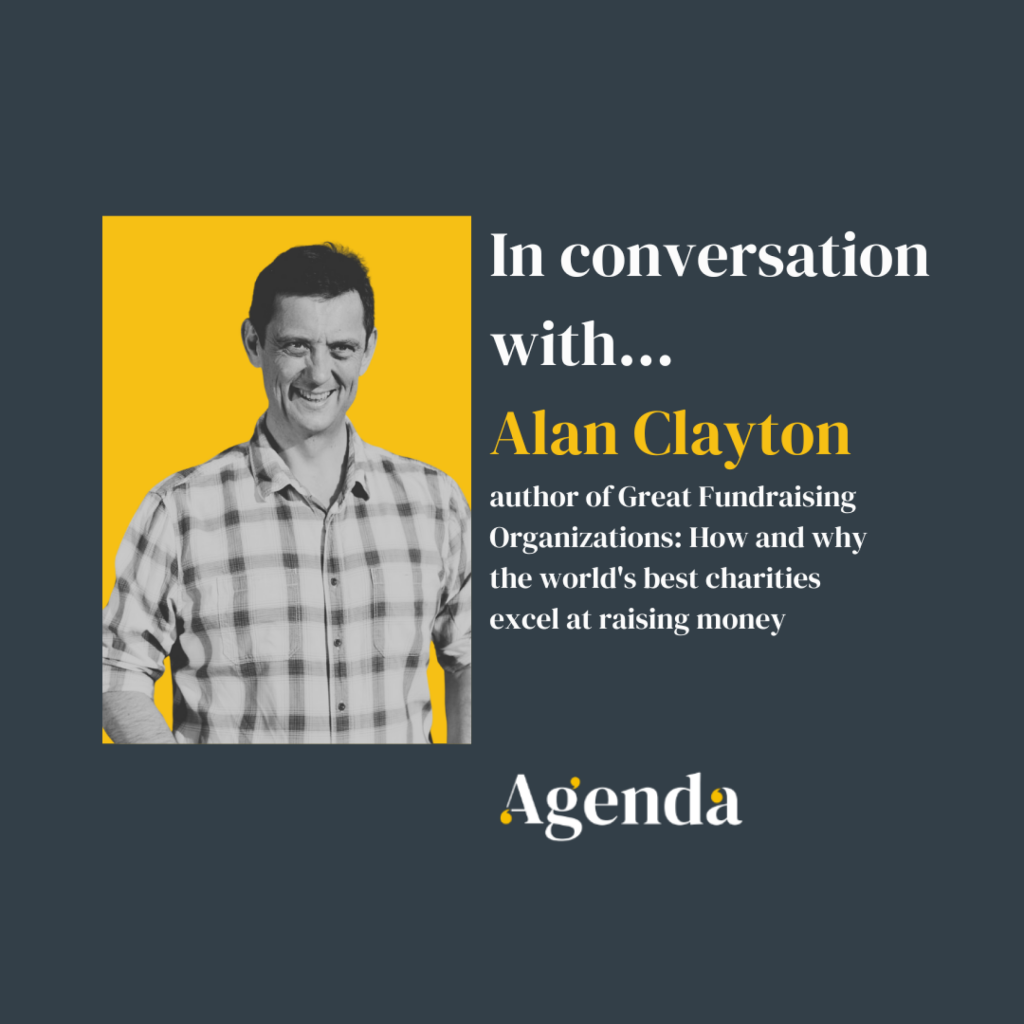Becky Slack: “So the book is called ‘Great Fundraising Organisations: Why and how the world's best charities excel at raising money’. How did the idea for this project come about?”
Alan Clayton: Raising money is actually quite simple: best possible product, best communications, sell it really well, treat people brilliantly. Four things, very straightforward. So why was it so bloody hard? We had concluded it was almost entirely behavioural, going far beyond fundraising into the whole organisation, including leadership. Then I had a gin and tonic with Professor Sargeant, and he said, any interest in getting that researched?
At the beginning we identified couplets of organisations – one effective, one not – fundraising for the same mission in the same market. We did gap analysis: what’s one doing the other isn’t? Immediate, stark differences gave us confidence. The biggest was the “impossible dream” – growth [was being] driven by big, unachievable promises, not impact or credibility. That was the first insight: the primacy of emotion. We repeated [the research] in other countries, always the same. Emotion, not overcoming objections, drives growth.
Can you give us an example of an impossible dream and where that played out within an organisation?
Oh yeah, I could show you 200. The original was NSPCC’s “Cruelty to children should stop. Full stop.” It made more than £500m. Then RNLI: “Save everyone.” International Justice Mission: “End slavery.” Children’s Hospices Across Scotland: “Keep the joy alive even in the face of death.” It’s the argument between credibility versus belief. NSPCC asked, reduce child cruelty by how much? People got angry – there’s no acceptable level. RNLI shifted from reducing drownings by 50% to “Save everyone.”
What are the other qualities and requirements to be a really great fundraising organisation?
It’s the ability to have a high-performing fundraising team with a brilliant product, and get all the other crap out of the way. This is the “two businesses, one mission” model. One side is academic, medical, scientific, public sector, or development – bureaucratic, slow, regulated, as it should be because if they make mistakes, they kill people or waste other people’s money. On the other side is fundraising, a fast-moving consumer goods business. If you slap on the same bureaucracy, you stifle it and you stop it working. They spend less time asking for money and more time managing processes, debates, opinions, protocol, etc.
And there is also the assumption that you are one organisation with one product. The services side of the business is selling the solution. Fundraising is selling the problem – the opposite of services. So they're not only different products, but they're the opposite to each other. So that bakes in all kinds of conflict into a fundraising organisation, which can then be unpicked and dealt with layer by layer by layer. Accept you have two businesses in one framework, then free up the fast-moving, the money-earning side.
Is there something also about culture and understanding of fundraising and how it works? I know you speak about the ethical intellectual culture. In my own experience of working as a fundraiser, there was definitely an element of snobbery around it. We were the dirty capitalists. In communications the same thing happens as well. The comms people are quite often thought of as the fluffy people sprinkling glitter on things, and we’re not considered as being as strategically important as we actually are.
This echoes the rest of the world. In an engineering firm you have 500 qualified engineers, then the salesperson – often least educated, often highest paid – because they do the one thing nobody else wants: sales. In the voluntary sector it’s exaggerated. Services need an ethical, intellectual culture; fundraisers need an ambitious, achiever culture. They don’t usually get on. Services think donors should want what they want. So they say: “Well, your job is to educate the donors to understand what we do”. Fundraisers say: “My job is to interpret so donors understand”. It's not the same thing at all. Then leadership wants integrated communications. So, you're going to have to try and take one ethical, intellectual set of communications, communicating the solution, and one simple emotional set of communications, communicating the problem, and you try to integrate them. Welcome to communications hell. The cultures are necessary, and both are admirable. Both are wonderful, but they are very, very different.
For the benefit of the audience, particularly those who might not have read the book, you talk about a red dot moment. Do you want to tell us what that is and why it's so important, and how other people can create one within their own organisations?
The red dot moment is the start of a surge in fundraising income, a shift from decline or flatline to growth. When we analysed historical data, no organisation grew in a straight line. Growth always came in surges, and you could trace each surge back to a single board meeting that triggered it. That became the “red dot moment”. The name is pure accident – I only had two Sharpies, one red and one blue – but it stuck.
The boring description is: it’s the board meeting where a new fundraising strategy is signed off. But what leads up to it is immense. The best boards look at fundraising not just from a governance perspective, but from an investor perspective. They believe in three things: first, the product – the idea, the impossible dream; second, the financial plan and their ability to monitor and manage risk; third, the people – not just their ability, but that the organisation is culturally behind the idea.
Until they have confidence in all three, no sensible board will commit. But once they do, that’s when growth takes off. We call it investor thinking because, in larger organisations, board members with business backgrounds immediately recognised it: it’s the same as investing in a bank or company. Watch Dragon’s Den – the failures believe the idea alone gets money; the successes know it’s the idea, the money and the people.
For most struggling organisations, reaching that red dot moment takes 12 months of education, development and diligence before the board is ready to commit.
Imagine that you're a fundraising director of a medium-sized organisation and you really want to grow. How do they create this red dot moment?
For mid-sized organisations, success comes down to leadership. Every time the CEO engaged, the organisation succeeded; every time they didn’t, it failed. So, get the CEO on board.
Most CEOs come from a service delivery background. They need to realise that increasing impact means learning how to earn money as well as spend it well. Open-mindedness, humility and mission drive are required – matching research on level five leadership. Once you have the CEO, nine times out of 10, the board follows, assuming the CEO stays long enough.
It also helps to approach the CEO from multiple directions. One fundraiser alone may be ignored. Fundraiser plus finance director, or plus head of programmes, or plus HR – that increases the chance of attention and success. Often it’s sideways management to get the CEO to commit.
If you then have programmes, fundraising, finance and the CEO aligned, it’s rare that a board will overrule that leadership team. Success isn’t based on opinion alone; it’s grounded in the organisation’s readiness and the CEO’s belief in the product, the people and the plan. The red dot moment and fundraising growth in these organisations always begins with CEO engagement. Without it, nothing else works.
In the book, you talk about how organisations that stagnate base their investment plans on budgetary needs but great fundraising organisations base it on financial aspirations. Talk us through that.
Every charity reports finances annually because regulators demand it. That’s useful for governance, but for driving growth, it’s about as useful as an ashtray on a motorbike. Growth requires planning over five, seven, 10 years, tracking aspirations, marginal gains, and acceleration. Short–term tracking is needed too – 90 days is about right for action planning.
The very best organisations separate governance from growth. Some boards spend two hours on governance, have lunch, and then two hours on growth. They look at different metrics: progress toward five- to 10-year goals, and the last 90 days’ data to adjust course. The key measure isn’t annual income, but lifetime value divided by cost per new donor. This applies across corporate, legacies, individual giving and community fundraising because it operates over the long term.
If you run an organisation based solely on this year’s return, nothing happens. You wouldn’t hire anyone; it takes time to develop capability. Investing now enables future growth. Boards and management teams that adopt this mindset move from governance to growth. They understand that short-term financial discipline is necessary, but aspirations and strategic investment are what drive fundraising success. It’s about balancing immediate accountability with long-term ambition.
In the book, you mention, quite rightly, a lot about audience. Any person on here who's a comms professional, and indeed a fundraiser, will know that audience is absolutely key. It's not about you, it's about them. And you gave a really nice example from the French charity, Trocaire, who started off with the strap line “The fight for justice”, and then you changed it to “Until love conquers fear”. Can you tell us about that? Because I thought that was a really nice story about framing.
In the Trocaire example, you had a Christian audience and a Christian organisation, but the services department had learned human rights language – “join the fight for justice” – to convince tens of thousands of older Catholic women to give. But those women don’t speak human rights; they speak church.
My favourite takeaway was from the head of programmes, who said after three days: “I’m very embarrassed. I’ve spent 10 years trying to teach the population of Ireland my language, when all I needed to do was learn theirs.” And that’s it in a nutshell. We’ve seen that time and time again.
How do you manage having different sets of messaging – for example, campaigners and service users who are also donors – without sending mixed messages? And can you share an example of when comms has helped unify that?
You are sending mixed messages out and there’s no way of avoiding it. The only worry is interference – what happens if the same person sees both? We measured that. They don’t even notice. They don’t realise it’s two different messages. It’s a false worry, according to the data.
So evidence-based communications comes in. You need the data and the stories. What often happens is the chief exec or leadership team get fed up with the two businesses arguing about how to communicate and, because they don’t know the solution, they try to find someone who does. They recruit a comms professional or a comms agency. In bad organisations, they don’t give them a brief, just put them in the middle and say, your job is to get the two to agree. You can’t win. The only way to win is to compromise, which ruins both sets of communications. And in the really bad organisations, brand becomes boss, tells everybody what to do and it kills your fundraising stone dead.
In successful organisations, leadership understand. They put comms in and say, your job is to take the unifying big idea and make that work for both services and fundraising. Same tone of voice, same personality, but delivering different products to different audiences. It’s about finding the point of unification – the common problem, solution and ambition that both sides can completely buy into.
An example is Make-A-Wish Canada. Make-A-Wish globally was stymied by brand policy – only positive images, trips to Disneyland. One CEO broke the mould, spoke about death wishes, and multiplied her income by 10. Canada followed. We worked through problem and solution hierarchy and got to: “Granting a wish will definitely improve family mental health, and it may even improve medical outcomes”. They said, “We believe it, but we can’t prove it, so we can’t put it in fundraising.” I said, “Two choices: accept a lesser claim and suffer, or prove it.” The chief exec said: “If we can’t prove that, I doubt we have a reason to exist.”
Over nine months, they got the data. They had the stories, then they had the data. Yesterday they relaunched: “Wishes are medicine”. Income has rocketed. That was comms-led, and it even changed the programme department because of what comms needed in order to be an awesome fundraising organisation.
You previously mentioned the dreaded C word, which is compromise. We worked with an organisation that wanted to change their name. Because of compromise, they ended up with three. No amount of evidence would persuade them this was not a good idea. Any tips for dealing with those moments?
It's quite easy to show people that if they compromise, they damage income and therefore the number of people they can help. The data can show that. What stops people is fear. Fear of criticism. Fear of being criticised in the media, by service users, by donors or, worst of all, by staff. People compromise to avoid criticism.
So you say: what we're going to do is tell the truth well and accept that some people are going to criticise us. It's an uncomfortable truth. That's what drives fundraising. Children are being abused. That drives fundraising.
So instead of putting energy into compromise, put energy into how we're going to react when criticised. The RNLI is the highest profile example. They were criticised for rescuing drowning families and migrants in the Channel. Some politicians and media called for people to stop giving. I was in the conversation. Within the hour we said: what’s our purpose? To save everyone. Are we embarrassed? No. We're proud. We're going to put it on the front page of our website: we are going to try and rescue everybody we can. Our only regret is that we cannot save them all.
What that did was extraordinary. About 200 people cancelled. About 16,000 made their first ever gift. It was a great example of not compromising. They were prepared, they bossed it. It was heartfelt and real.
If there's one key takeaway that you want people to take away from today about what it is to be a great fundraising organisation. What is it?
One word: confidence. If you are 100% confident, you will raise money. Confidence comes from two things: clarity and certainty. Clarity plus certainty equals confidence.
And clarity and certainty come from the precise definition of the problem you are trying to solve in a way you can communicate. The vast majority of organisations are too amorphous, too vague, too compromised. And it’s not always the obvious.
So what problem is a children’s hospice trying to solve? It’s not going to save the life of the child. It’s that they don’t want the joy to die with the child. That insight took two and a half days to realise, but they’ve raised tens of millions on the back of it.
Finding your unique place starts with that question: what problem are we trying to solve? It’s much harder to identify than most people realise. Once you have it, you have certainty and clarity, and that equals confidence. And when you have that, the money will come.
This is an abbreviated version of In Conversation With... Alan Clayton, which took place on Wednesday 10 September 2025. You can watch the full interview here.
You can buy the book here.
To make sure you don’t miss out on future Agenda events, sign up to our newsletter.




